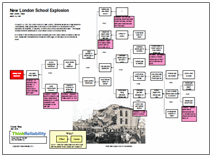A leak from the Elgin platform in the north sea near Aberdeen has the potential to cause an explosion due to the proximity of the leak to the still-lit flare on the platform. However, the wind is currently blowing gas away from the flare. The potential for environmental damage is not as great as that of Deepwater Horizon because it is a surface, rather than underwater, leak.
Workers on the now-evacuated Elgin rig noticed the leak on March 25, 2012. The rig was partially, then later fully, evacuated. We can examine the causes of the environmental leak, as well as the potential for further damage, in a visual root cause analysis in the form of a Cause Map. The Cause Map lays out the cause-and-effect relationships in a clear, intuitive way.
 We begin with the impacts to the goals. The safety goal is impacted because of the potential for an explosion. The environmental goal is impacted due to the gas leak, estimated to be approximately 200 cubic metres per day. The customer service goal is impacted due to the loss of value of the owner corporation stock shares. Production is currently shut down on the rig, leading to an impact to the production goal. The potential for an explosion could also cause catastrophic damage to the platform, which is an impact to the property goal. Lastly, the evacuation of the platform is an impact to the labor goal.
We begin with the impacts to the goals. The safety goal is impacted because of the potential for an explosion. The environmental goal is impacted due to the gas leak, estimated to be approximately 200 cubic metres per day. The customer service goal is impacted due to the loss of value of the owner corporation stock shares. Production is currently shut down on the rig, leading to an impact to the production goal. The potential for an explosion could also cause catastrophic damage to the platform, which is an impact to the property goal. Lastly, the evacuation of the platform is an impact to the labor goal.
In order for an explosion to occur, there must be fuel, oxygen, heat and confinement. In this case, the oxygen is provided by the atmosphere, and the confinement is provided by the well itself. The fuel is provided by the gas leak, believed to be entering from another non-producing well through a crack in the outer casing of the well, which was in the process of being plugged and abandoned. The heat likely to cause the explosion is a flare on the platform. The flare burns off excess gas from the platform and was not extinguished during the evacuation, as the priority was to remove the workers.
The flare is unable to be turned off remotely, but options for extinguishing the flare are being evaluated. Other options being evaluated to stop the leak and reduce the potential for explosion include digging a relief well or killing the well that is currently leaking. All options have the potential to be very expensive.
To view the Outline and Cause Map, please click “Download PDF” above.




